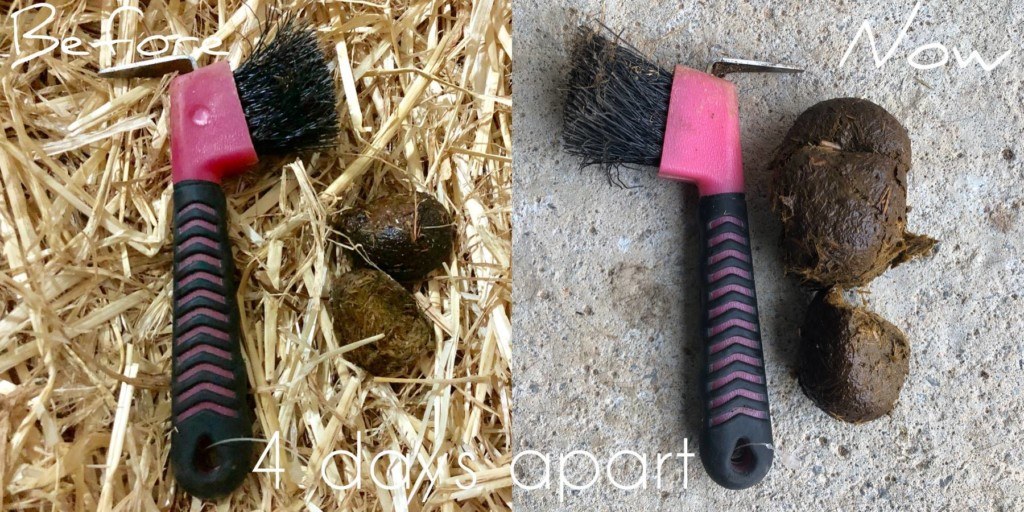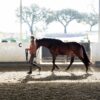From this update from Falcao’s journey you will learn:
– Why what we commonly understand as “stretching” is not really stretching but sliding, and we should focus on lubricating tissues rather then mechanically pulling them apart,
– How Hydration can significantly improve your horse’s range of movement and flexibility of his body,
– Why&How the size of your horse’s poo matters.
_________________
Last week we had another major breakthrough on our journey with Falcao. Falcao is a 7yo Lusitano stallion who joined OHL for trainings on the last day of 2017. Today, is the 10th day since he came, and I am journaling here his journey for you.
One of the big breakthroughs of the last week was:
FALCAO LOWERING HIS HEAD IN TROT
Wait. Isn’t it something normal that every horse should be able to do and perform? No. It can be something very difficult for many horses whose fascia is tensed.
Fascia is a collagen joining tissue of the body. Fascia keeps all the organs at the given place, and connects all the pieces of the body. Fascia is more like a 3D spider web that goes in many dimensions through the body and on top of the layers of the body tissues (organs, glands, muscles…), than like a thin layer on top of the given pieces of the muscles. The role of fascia in the body is now researched by the top sports medicine scientists, and new discoveries about it’s role are coming every single week.
The last Olympic Games popularized some of the new insights about role of the fascia in movement range. USA Olympic athletes had visible “red spots” on the body coming from using the technique called as cups. (For my Polish followers: we know cups since ages under the name of “bańki”). The role of the cups was to mechanically create more space in fascia. New space combined with special exercises substantially improved the range, and reach of the athletes’ movement.
We can compare this phenomenon to changing the size of a pillow case in which you have the pillow-stuffing. When the stuffing is too big for the pillow-case, the pillow becomes very stiff and feels hard when we touch it. There is no space to re-adjust the pillow-stuffing within the pillow-case, because it holds it so strongly and with such a tension. However, when you change the pillow-case size, and put the same stuffing into a bigger pillow-case, it appears as soft, and the stuffing is more mobile, you can easily adjust it and make it soft and comfortable for yourself.
OK. How this applies to our case with Falcao?
When he came to me, his body was very tensed, up to the point where the skin was so hardly attached to the body that one could hardly grab it. It was neither sliding, nor rolling on the body. The muscles felt like hard play-doh pieces in plastic bags. This told me much about how stressed he was, and how much his fascia was tensed due to previous trending/environment impact.
The first reaction from a trainer in such a situation could be to start stretching the horse, and gradually provide more mobility into the body and tissues.
Recent discoveries from the field of sports medicine show that when the body is being stretched NOTHING IS REALLY LENGTHENING ! neither the ligaments nor the muscles.
So how the bigger range of the movement appears?
THANKS TO HYDRATION ‼️
Wait. What does it really mean? Hydration in sport is obvious. Everyone knows that a top athlete has to drink lots of fluids and supplement electrolytes prior and past the trainings. Top tennis players are weighted before and after the trainings, and get behavioral rewards for keeping their weight same throughout the workout, before it, and after it (which means that they are not dehydrated).
Does it mean that to lengthen the horse’s tissues is enough to make sure he drinks a lot?
Not really. When it comes to fascia newest discoveries, again popularized by the last Olympic Games, say that what we see as “stretching” is in fact ABILITY OF THE LAYERS OF FASCIA TO SLIDE ONE ON TOP OF ANOTHER ‼️
This ultimately is why allowing horses the possibility of movement 24/7 is so important. When the horse is kept in the box, the ability of the layers of fascia to slide one on top of another becomes greatly compromised. It literally becomes sticky, as if you put glue or very sticky honey between it’s layers.
When you hydrate the body, the fluid between the layers of the fascia can allow better slide for the fascia layers.
“STICKINESS” OF FASCIA IS ALSO CAUSED BY STRESS.
When the body tenses, the ability of every tissue of the body to HOLD WATER is being compromised significantly. In our case, what changed so dramatically Falcao’s ability to lengthen the frame was not the usage of gadgets to mechanically caused desired position, neither positive training methods.
I saw him really wanting to take the head down, but the body was kind of “holding him”. With tons of Calmness, BodyMarc DUO sessions during which I was consciously increasing range of the movement through relaxation of fascia, and LOTS OF MOVEMENT we reached our goal: MORE FLEXIBILITY OF THE BODY.
From this point we can start building up his muscles, because the body moves in the relaxed way, using it’s natural balance.
OBSERVE YOUR HORSE’S MOVEMENTS
(and I am not only speaking about his legs, and head&neck position!!!)
What else was a significant sign of tensed fascia except of a really stiff body and the skin glued to the muscles? Well, the size of the poo: When Falcao arrived to our place, I have to tell you that his poo was ridiculously small. It looked like a poo of a pony, and not a grown-up horse. Of course, changing the diet to a forage based one was a very important factor in increasing the size of the poo, but we cannot reject here also the importance of the relaxing of the fascia which played a huge role here.
When fascia is tensed it squeezes internal organs, this ultimately is visible also though the size of your horse’s “apples”. A healthy, relaxed horse should have a nicely formulated, round-looking, normal-sized “apples”. If the big horse has a poo in the size of a pony’s or a foal’s poo, you can be sure that something is NOT OK!
To summarise: To have good results in horse training, and to significantly improve your horse’s body flexibility and range of motion you have to:
– MAKE SURE THAT FASCIA IS RELAXED,
– TAKE CARE OF YOUR HORSE’S HYDRATION.
Without hydration layers of fascia cannot slide one on top of another, and the movement range is stiff and limited.
Hydration is not only providing water and electrolytes. Good Hydration means: relaxing the body and preparing it to absorb this water and store it between the layers of fascia.


